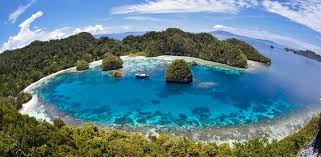
1. Raja Ampat, Indonesia: A Paradise for Nature Lovers
Raja Ampat, Indonesia is a remote archipelago located off the northwest tip of Bird’s Head Peninsula in West Papua. Comprising over 1,500 small islands, this spectacular region is famed for its dramatic limestone cliffs, secluded lagoons, and pristine coral reefs. It’s one of the few places on Earth where you can still find untouched natural beauty in its purest form.
What makes Raja Ampat truly unique is its staggering biodiversity. Recognized as one of the most biodiverse marine ecosystems on the planet, this destination is perfect for eco-tourists and nature enthusiasts alike. Whether you’re hiking jungle-covered islands or snorkeling in transparent waters teeming with colorful fish, Raja Ampat is a sensory feast that never fails to impress.
2. World-Class Diving and Snorkeling Experiences
Raja Ampat, Indonesia is often dubbed the “Amazon of the Seas” due to its unparalleled underwater biodiversity. Divers and snorkelers from around the globe are drawn here for the chance to explore its thriving coral gardens, which host over 550 coral species and more than 1,500 species of tropical fish. Iconic dive spots such as Cape Kri and Manta Sandy offer unforgettable encounters with manta rays, reef sharks, and vibrant schools of fish.
Snorkeling is just as rewarding as diving in Raja Ampat. The crystal-clear waters provide incredible visibility, allowing even novice swimmers to enjoy the vibrant underwater scenery. With marine sanctuaries located throughout the region, responsible tourism efforts have helped preserve this underwater paradise for future generations.
3. Untouched Beaches and Hidden Lagoons
The beaches in Raja Ampat, Indonesia are some of the most pristine in the world. Powdery white sands meet turquoise waves in secluded bays framed by lush jungle and dramatic karst formations. Whether you’re seeking a quiet place to relax or a romantic escape, Raja Ampat delivers a truly tranquil experience.
Hidden lagoons and secret coves are scattered throughout the islands, waiting to be discovered. These lesser-known spots provide a more intimate look at the region’s stunning landscapes. Kayaking through calm waters, surrounded by towering limestone cliffs and exotic birdcalls, feels like stepping into another world entirely.
4. Local Culture and Indigenous Communities
While Raja Ampat is known for its natural wonders, the cultural experiences are equally enriching. The region is home to several indigenous Papuan tribes, each with their own traditions, languages, and lifestyles. Visitors can engage with these communities to learn about traditional boat-making, local folklore, and ancient customs that have been passed down through generations.
Participating in cultural activities such as a traditional dance performance or a cooking class using local ingredients provides meaningful insights into life in Raja Ampat, Indonesia. Responsible tourism that respects and supports local traditions helps sustain these vibrant communities and ensures their stories continue to be told.
5. Responsible and Sustainable Tourism
Raja Ampat, Indonesia has become a model for eco-friendly travel. The local government and NGOs work closely with villages to maintain strict conservation practices that preserve the fragile ecosystem. Visitors are encouraged to support sustainable tourism by staying at eco-resorts, using reef-safe sunscreen, and following local guidelines for marine protection.
Tourism here is carefully managed to minimize environmental impact. Entry fees are reinvested into community development and conservation projects, making visitors active participants in preserving this paradise. Traveling sustainably in Raja Ampat ensures future generations can enjoy its wonders just as we do today.
6. Breathtaking Views from Iconic Viewpoints
One of the most photographed places in Raja Ampat is the Piaynemo viewpoint. After a short but steep hike, visitors are rewarded with panoramic views of a surreal landscape dotted with tiny karst islands surrounded by clear, turquoise waters. It’s a perfect spot for photographers and nature lovers seeking a bird’s-eye view of this magical region.
Other viewpoints like Wayag Island offer equally stunning perspectives. Climbing to these lookouts not only offers great photo opportunities but also a profound appreciation of Raja Ampat’s vastness and beauty. Sunrise and sunset from these high points are especially magical, bathing the islands in golden light.
7. Practical Travel Tips for Visiting Raja Ampat
Getting to Raja Ampat, Indonesia involves a bit of effort, but the reward is well worth it. Most travelers fly into Sorong, West Papua, and then take a ferry or speedboat to the islands. Booking tours or accommodations through reputable eco-tour operators can streamline the process and ensure a smoother journey.
Travelers should prepare for limited Wi-Fi and modern amenities, as many areas are remote. Bring cash, reef-safe sunscreen, and respect local customs. Planning ahead, especially during the dry season (October to April), guarantees the best experience while helping protect this ecological treasure.
Final Thoughts: Why Raja Ampat, Indonesia Is a Must-Visit Destination
Raja Ampat, Indonesia is more than just a stunning travel destination—it’s a sanctuary of natural beauty, cultural richness, and ecological importance. From its vibrant coral reefs and tranquil beaches to its welcoming local communities and breathtaking viewpoints, every moment spent here is unforgettable. Whether you’re an adventurer, a nature enthusiast, or simply someone in search of peace and wonder, Raja Ampat promises an experience like no other. Start planning your journey to this hidden gem today and discover why it’s truly one of the world’s last unspoiled paradises.
4o






